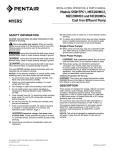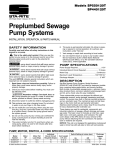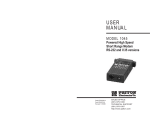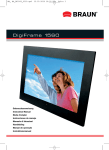Download Digi-Frame DF-1045s User manual
Transcript
1. Product Introduction: Digital Photo Frame Congratulations! You are the proud owner of a new 10.4” DigiFrame. Boasting high-quality image resolution the DigiFrame is the perfect way to display your Digital Photos. Your DigiFrame can be configured to display Photos in a slide show or as a still Photo. You can now display all your favorite Photos or video files for everyone to see! 2. Package Contents: User Manual Before using your DigiFrame, be sure to check all the accessories are in the box. Your DigiFrame comes with the following items: · Digital Photo Frame x 1 · Stand x1 · AC adapter x 1 · Remote Control x1 · User Manual x1 3. Features: Display Photo and video files without a computer Listen to MP3 files while displaying photos Simple to operate: insert your memory card into the photo frame to view Photo and video files or listen to MP3 Supports: CF—MS/SD/MMC—SM /XD Multi Media cards TFT-LCD screen with high resolution, wide view angle and rich color Easy to use remote control for displaying and managing your files Built-in stereo speakers Accessories 1. Remote Control 2. AC Adapter 3. Operation Manual 4. Specifications Model DF-F1043b, DF-1044r & DF-1045s Unit Size Display Area 314(h) x 257(v) x40(d) 211.2(h) x 158.4(v) Resolution 640x480 Colors 262,144 Brightness 350cd/m2 max. Contrast angle 300:1 Viewing angle 70/70 (l/r),70/40(u/d) I t lt Operation Temperature AC100—240V(50HZ—60HZ) 0 ---50 Net Weight 1.5kg Media Supported MPEG1/2/4, MP3/JPEG Cards Supported CF /MS/SD/MMC/SM/XD Auto Start Mode Auto Slide Show JPEG Photo Playback Mode 1. Loop, Zoom In 2. Auto Slide Show 3. Slide Show with background MP3 music 4. File name, File size, Resolution, Date Display 5. Interval Time Setup 6. Transition Setup 7. Play/Stop/Pause Music Playback Mode 1. Play/Stop/Pause 2. Volume Adjust 3. Repeat Model Setup 4. File Type, Total Time, Date, Display Video Playback Mode 1. Play/Stop/Pause 2. Volume Adjust 3. Zoom in 4. File information, Time and Date Display 5. Control and Memory Card Slots Display Decorative Frame Desktop Stand AV Power Auto Menu Volume Power SM/XD Arrow MS/SD/MMC/CF 6. Setting up your DigiFrame ·Open the package and remove your DigiFrame from the protective packaging. ·Plug the AC adapter into a power outlet. Plug the other end into the unit. ·Insert your memory card into the designated slot. ·Turn power to On position via the On/Off Button. The power button is on the right hand side of the frame ·Your photo files will be displayed randomly for your viewing pleasure. 8. Playing a Slideshow with Music background 7 A. Press the “Music” key on your remote to enter the Music database. Use the arrow keys to select the desired music file. B. Press “Slideshow” key on your remote. Your DigiFrame will play the selected MP3 while playing a slideshow of your photos. 9. Replacing Remote Control Battery 7. Remote Control: 1—Remove the battery compartment cover by pulling the cover in the direction of the arrow. 2—Remove the battery. 3—Insert the replacement battery taking note of the correct polarity (+/-). 4— replace the cover. Caution: 1. Only use a 3V CR2025 battery. 2. Dispose of used batteries according to local ordinance regulations. 3. Remove the battery when not using the Flash Player for prolonged periods. Multiple Cards Screen System Setup • Press the Power button on your remote control to power up the system. If no media card is detected you will see:”NO MEDIA DETECTED” Multiple Cards in System If the Card Reader contains more than one device/card, the Multiple Cards Screen will appear. Use the Up/Down navigation buttons to move through the selections and press Enter to select. If only one device is present, the Multiple Cards Screen will not appear. Multiple Contents in Card If there is more than one type of file in the device/card, the Multiple Contents Screen will appear. Use the Left/Right navigation buttons to move through the options and press Enter to select. If only one file type is present in the card, the Multiple Content Screen will not appear. Photo Setup The Photo Setup is illustrated in the following section. Thumbnail Digest The (photo) Thumbnail Digest Setup Screen is shown below. Use the navigation buttons to move through the options and press Enter to select. Multiple Contents Screen Setup Main Page The Setup Main Page is shown below. Use the navigation buttons to move up and down the options and press Enter to select. Please note “Preferences” is only available without a media card inserted. Thumbnail Digest Setup Screen • Selecting ON will display the photo thumbnails using the original thumbnail files created by the digital camera and stored within the memory stick. This process will help to display thumbnails of large photos in a short time. (Factory default mode) • Selecting OFF will display the photo thumbnails by decoding the photo and scaling down to fit into the display area allocated for the thumbnail. This process may take a longer time if the photos are of high resolutions (big files). Setup Main Screen Slideshow Mode Music Setup The Music Setup is illustrated in the following section. The Slideshow Mode Setup Screen is shown below. Use the navigation buttons to move through the options and press Enter to select. Repeat Mode The Repeat Mode Setup Screen is shown below. Use the navigation buttons to move through the options and press Enter to select. Slideshow Setup Screen Repeat Mode Setup Screen • Selecting ONE will repeat the highlighted music continuously, until the Stop button is pressed. • Selecting ALL will repeat all the music files in the music library continuously, until the Stop button is pressed. (Factory default mode) • Selecting OFF will disable the repeat feature. Music playback will start from the highlighted music file through to the last music file found in the music library and then stop. (The Repeat button on the remote control can still provide the Repeat feature if so desired) • Selecting MANUAL will give full control of the photo slideshow timing to the user. The user will need to use the navigation keys of the remote control to scroll through the photos stored in the memory card. This will allow each photo to be displayed as long as is desired. • Selecting AUTO will make the photo slideshow start automatically after displaying the photo thumbnails for about 10 seconds. (Factory default mode) Interval Time Folder Repeat The Folder Repeat Setup Screen is shown below. Use the navigation buttons to move through the options and press Enter to select. The Interval Time Setup Screen is shown below. Use the navigation buttons to move through the options and press Enter to select. Interval Time Setup Screen Slideshow Setup Screen • Selecting ON will turn on the repeat mode indefinitely, until the Stop button is pressed. (Factory default mode) • Selecting OFF will turn off the repeat mode. i.e. Your DigiFrame will slideshow your photos only once and then stop. • You can set your DigiFrame to show each photo for 1, 3, 5, 10, 30 or 60 seconds by navigating to and pushing the enter key on the desired interval – OR use the “Slide Transition” key on your remote during normal operation and this will change the transition time “on screen”. Set to the desired transition time and wait until the On Screen Display disappears. The selected Interval time is now set. 7: Left to Right (roll) Transition Setup Page The Transition Setup Screen is shown below. Use the navigation buttons to move through the options and press Enter to select. Auto Start Setup Page The Auto Start Setup Screen is shown below. Use the navigation buttons to move through the options and press Enter to select. Transition Setup Screen • Selecting FULL SCREEN will display the full photo in a full screen (instant) transition. (Factory default mode) • Selecting the other modes will display the photo using the transition chosen. The photo transition choices are: 1: Full Screen (instant) 7: Left to Right (roll) 2: Top to Bottom (roll) 8: Right to Left (roll) 3: Bottom to Top (roll) 9. Left/Right to Centre (Roll) 4: Top/Bottom to Center (roll) 10. Centre to Left/Right (Roll) 5: Center to Top/Bottom (roll) 11. Corners to Centre (Implode) 6: Top to Bottom (blind) 12. Left to Right (Blind) 13. Random (mixture of the above options) Transition Setup Screen • Selecting ON will start, after power on, the automatic playback of all the photo, music, and video files found in the Memory card. • Selecting OFF disables the automatic playback of all contents after powering on the system. (Factory default mode) Movie Setup The Movie Setup is illustrated in the following section. Interval Time The (Video Thumbnails) Interval Time Setup Screen is shown below. Use the navigation buttons to move through the options and press Enter to select. Interval Time Setup Screen • Selecting FAST will display the video thumbnails at a faster rate, using the first frame of each video as its thumbnails. • Selecting NORMAL will display the video thumbnails with a three seconds playback of the videos in QCIF mode. This takes a longer time to fill up the thumbnail page. Video Output OSD Language The Video Output Setup Screen is shown below. Use the navigation buttons to move through the options and press Enter to select. The OSD Language Setup Screen is shown below. Use the navigation buttons to move through the options and press Enter to select. OSD Language Setup Screen Video Output Setup Screen • Selecting S-VIDEO will output the video to Composite and S-Video. (Factory default mode) • Selecting YPBPR will output the video to Component video in Progressive YUV mode. (ES6420FP only) • Selecting RGB will output the video to VGA. (ES6420FP only) • Selecting ENGLISH will display the OSD in English. (Factory default mode) • Selecting CHINESE will display the OSD in Chinese. • Selecting JAPANESE will display the OSD in Japanese. DEFAULTS Digital Photo Display —— The Factory Default Setup Screen is shown below. Use the navigation buttons to move through the menu options. Use the RESET button to restore the factory default settings. Default Setup Screen Note: All setting changes are saved in the non-volatile EEPROM in the system. The digital photo display is initiated in three ways: (1) only photos are present in the device/card, (2) the Photo option was selected from the Multiple Contents in Card screen, or (3) the Photo shortcut button on the remote control was pressed. In the digital photo display mode, the Photo Thumbnails Screen will appear. All the photos found in the device/card will be displayed in continuous pages of photo thumbnails. If the device/card has more than one folder and you desire to view the photos by folder, go to “File Library Management” for how to access individual folders. Use the navigation buttons to move through the thumbnails in the thumbnail page, and use the I<< and >>I buttons to jump to the previous or next page of thumbnails. If the Slideshow Mode option in the SETUP menu is set to AUTO, the Photo Show will start automatically after about ten (10) seconds. If the Auto Start option in the SETUP menu is set to ON, the playback of all files at Power-Up would be in effect and the Photo Thumbnails Screen will not be visible. To access the Photo Thumbnails Screen press “Photo” key on your remote. • Press the ROTATE button on the remote control to change the rotation of a photo. Not available when in Music Slideshow. • Press the ZOOM button on the remote control to zoom-in the display by a factor of 2X, 3X, and 4X. Pressing ZOOM once more will return the display to its original state. While in the Zoom mode, use the navigation buttons to pan the display Left, Right, Up, or Down. Not available when in Music Slideshow. Photo Thumbnails Screen • Press the HOME button on the remote control to jump to the main level of the DMP software application. • Press the DISPLAY button on the remote control to view, by OSD, the • Press the ENTER button on the remote control to display the highlighted thumbnail in full-screen. Once in full-screen, pressing the ENTER button again will return to the Photo Thumbnails Screen. • Press the PLAY/PAUSE button on the remote control to start the Photo Show. Once in photo show, press PLAY/PAUSE button to pause or resume the Photo Show; press the STOP button to return to the Photo Thumbnails Screen. • If so desired, press the DELAY button on the remote control to set a new time delay of your choice for the display of the photos, different from the settings in the SETUP menu. • If so desired, press the REPEAT button on the remote control to set a new repeat mode of your choice, different from the settings in the SETUP menu. • If so desired, press the TRANSITION button on the remote control to set a new photo display transition mode of your choice, different from the settings in the SETUP menu. • Press the M-SLIDE button on the remote control to initiate the Music Slideshow. Music files must be present in order to have music; otherwise, it will only be a Photo Show. Music Slideshow can be initiated either from the Photo Thumbnails Screen or after the Photo Show has started. properties of the photo displayed on screen. • Press the MUSIC button on the remote control to jump to the Music Library Screen. If no music file is present, no action takes place. • Press the VIDEO button on the remote control to jump to the Video Thumbnails Screen. If no video file is present, no action takes place. • Press the FILE button on the remote control to jump to the File Management Screen. • Press the PLAY/PAUSE button on the remote control to pause or resume the music. • Press the STOP button on the remote control to stop the music. Digital Music Playback —— The digital music playback is initiated in three ways: (1) only music files are present in the device/card, (2) the Music option was selected from the Multiple Contents in Card screen, or (3) the Music shortcut button on the remote control was pressed. In the digital music playback mode, the Music Library Screen will appear. All the music files found in the device/card will be displayed in a continuous list of music files. If the device/card has more than one folder and you desire to playback the music files by folder, go to chapter six “File Library Management” for how to access individual folders. Use the navigation buttons to move through the music files. The highlighted music starts to play automatically. Press STOP to stop the playback. If the Auto Start option in the SETUP menu is set to ON, the playback of all files at power-up would be in effect and the Music Library Screen will not be visible. • If desired, press the REPEAT button on the remote control to set a new repeat mode of your choice, different from the settings in the SETUP menu. –REPEAT ALL: repeats all the files in the library sequentially –REPEAT ONE: repeats the highlighted music only –REPEAT OFF: music stops when the end of the library is reached. • Press the M-SLIDE button on the remote control to initiate the Music Slideshow. Photos must be present in order to have slideshow; otherwise, it will only be music playback. • Press the VOL button on the remote control to adjust the volume • Press the MUTE button on the remote control to mute music. • Press the HOME button on the remote control to jump to the main level of the DMP application. • Press the DISPLAY button on the remote control to display a Graphics Equalizer to accompany the music playback. Pressing DISPLAY again will hide it. • Press the PHOTO button on the remote control to jump to the Photo Thumbnails Screen. If no photo file is present, no action takes place. • Press the VIDEO button on the remote control to jump to the Video Thumbnails Screen. If no video file is present, no action takes place. Music Library Screen • Press the FILE button on the remote control to jump to the File Management Screen. Digital Video Playback The digital video playback is initiated in three ways: (1) only videos are present in the device/card, (2) the Video option was selected from the Multiple Contents in Card screen, or (3) the Video shortcut button on the remote control was pressed. In the digital video playback mode, the Video Thumbnails Screen will appear. All the videos found in the device/card will be displayed in continuous pages of video thumbnails. If the device/card has more than one folder and you desire to view the videos by folder, go to chapter six (6) “File Library Management” for how to access individual folders. Use the navigation buttons to move through the thumbnails in the thumbnail page, and use the I<< and >>I buttons to jump to the previous or next page of thumbnails. If the Auto Start option in the SETUP menu is set to ON, the playback of all files at Power-Up would be in effect and the Video Thumbnails Screen will not be visible. • Press the ENTER button on the remote control to playback the highlighted thumbnail in full-screen. Once in full-screen, pressing the ENTER button again will return to the Video Thumbnails Screen. • Press the PLAY/PAUSE button on the remote control to start the Video Show. Once in Video Show, press PLAY/PAUSE button to pause or resume the Video Show. . Press the STOP button to return to the Video Thumbnails Screen. • Press the VOL button on the remote control to change the volume of the video. • Press the MUTE button on the remote control to mute video. • Press the HOME button on the remote control to jump to the main level of the DMP application. • Press the DISPLAY button on the remote control to view, by OSD, the properties of the video displayed on screen. • Press the PHOTO button on the remote control to jump to the Photo Thumbnails Screen. If no photo file is present, no action takes place. • Press the MUSIC button on the remote control to jump to the Music Library Screen. If no music file is present, no action takes place. • Press the FILE button on the remote control to jump to the File Management Screen. Video Thumbnails Screen File Library Management The File Library Management is initiated by either selecting File from the “Multiple Contents in Card” screen or pressing the File shortcut button on the remote control. Devices The Device Selection Screen is shown below. Use the navigation buttons to move through the options and press ENTER to select. The File Library Management Screen will appear. Use the navigation buttons to move through the thumbnails and press ENTER to select. File Library Management Screen • Selecting DEVICES allows a user to switch to a different device/card. • Selecting a photo folder (i.e. PHOTOS) allows a user to manage the Photo Library. • Selecting a music folder (i.e. MP3 MUSIC) allows a user to manage the Music Library. • Selecting a video folder (i.e. MOVIES) allows a user to manage the Video Library. Device Selection Screen Photos Library Music Library The Photos Library Screen is shown below. Use the navigation buttons to move through the photos. You will see a preview of each photo as well as its file properties. Photos Library Screen The Music Library Screen is shown below. Use the navigation buttons to move through the music files. The highlighted music starts to play automatically with the file properties displayed. Music Library Screen • Pressing ENTER on the remote control will start the playback of all the music files beginning from the highlighted music file until the last music file in • Pressing ENTER on the remote control will start a Photo Slideshow from the photo currently highlighted. While in the Photo Slideshow, all features such as Delay, Repeat, Transition, Rotate, Zoom, Pause, and Resume will work, and pressing ENTER or STOP will return the display to the Photos Library Screen. the library, with a Graphics Equalizer display. While in music playback mode, all the features such as Next, Previous, Pause, and Resume will work, and pressing ENTER or STOP will return the display to the Music Library Screen. Videos Library The Videos Library Screen is shown below. Use the navigation buttons to move through the videos. You will see a preview of each video as well as its file properties. Video Library Screen • Pressing ENTER on the remote control will start a Video file from the video currently highlighted. While in the Video Show, all the features such as Next, Previous, Pause, and Resume will work, and pressing ENTER or STOP will return the display to the Video Library Screen.


























